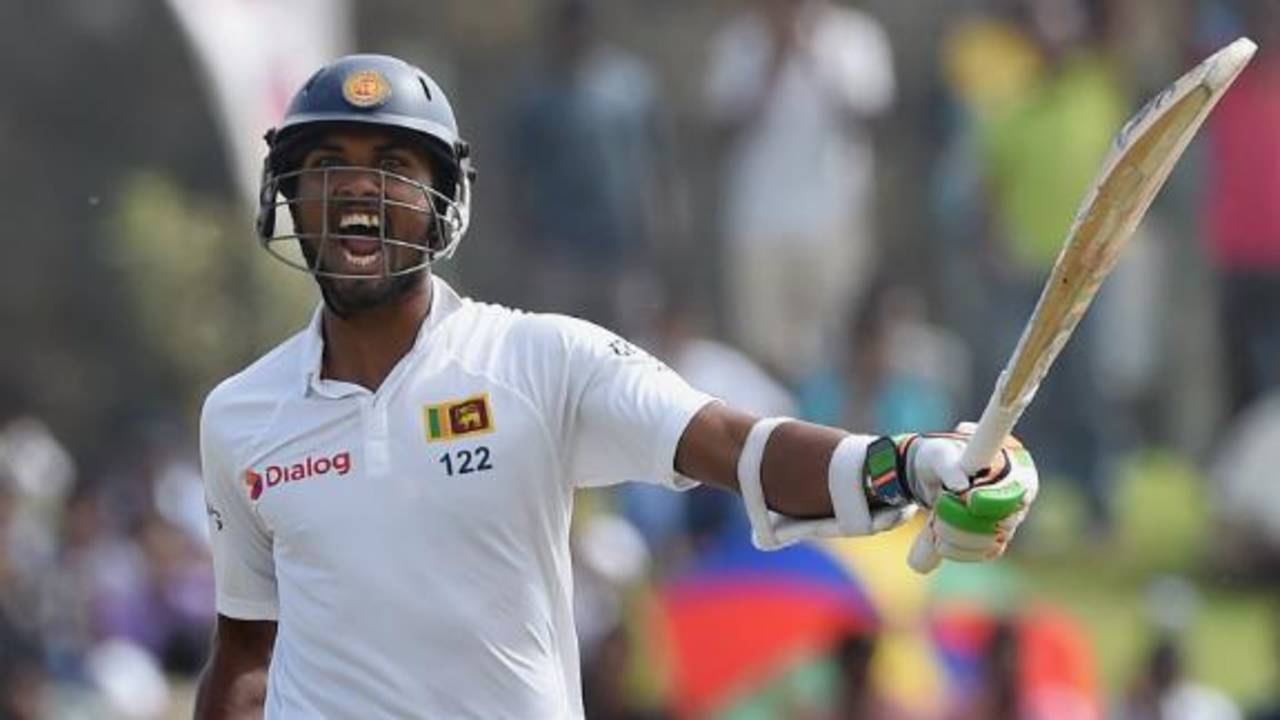India's boat knocked sideways by Chandimal
Sri Lanka sensed a slightly soft centre in India's much-advertised aggressive approach. If anything, competitors pick up the smallest of signs and the Indians gave out a few big ones today
Sharda Ugra in Galle
14-Aug-2015
About eight nautical miles off the coast of Sri Lanka, about 15kms from Galle, the continental shelf that south Asia is rested on, breaks off, the Indian Ocean dropping into marine canyons and the deep sea. India find themselves not so far away from that that kind of an edge. From a position of sure-footed security at the start of the third day in the Galle Test, they were made to get their sea legs going into day four. After session after session of crisp and controlled cricket, on course to win the Test inside three days, India were knocked sideways by Sri Lanka. Or rather, by Dinesh Chandimal for over two hours. The tide of the match has not changed yet, but the Indian boat has certainly been rocked.
Tests in Galle usually begin with easy-to-handle narratives but as they head towards the finish, they take on a life of their own - featuring drama and turnarounds, suspense and shredded nerves. Like those movies with breath-snatching twists at the end. Galle promises a wild weekend, too. Except, here everything is for real.
To return to hard numbers: at the end of day two, Tharindu Kaushal had said he believed Sri Lanka could defend around 250, but the truth is that the highest successful chase in Galle is a piffling 99. It is Chandimal who has set up this action thriller, playing several key parts through his blistering, post-lunch counter-attack. He gave Sri Lanka the fuel needed to turn this Test into contest, took the match into its fourth day and also gave India much to think about.
Their bowling was under attack in away conditions - not through the expected ennui of slow, low turners and long days in the field, as they had expected - but another kind of attack. Chandimal turned the field and common sense around through a series of reverse sweeps and switch hits, with the willingness to risk it all.
The three decisions that went against India before lunch will no doubt cause much anguish. But it is best that they remember it as a bad-umpiring virus that has run through this game. Both in terms of the number of errors and the degree of the bloopers given and taken on both sides.
India had squeezed the Lankan innings enough to believe they deserved to have them five down at the break before the umpiring handouts. Truth is, they did have 45 minutes in the shade, to kick a few kit bags, curse officialdom the ages, darkly mutter about DRS and then, with adult counsel and some food, work out that they had been dealt a bad hand and move on.
India knew what their tactic had to be, as Ajinkya Rahane said later, "to give as little runs as possible." When Chandimal forced the bowlers to change the very angles that they were coming at him from, they ran into a wall. With the old ball and a slowing wicket, they could not find a plan-B. They lost their tightness and control of lengths, and the stinging turn at the start of the day was negated. Chandimal's tactics were very simply evident, but none of the spinners found the variety or the fizz to land the ball where it could negate the angles he was reworking.
After two firestarter partnerships with Lahiru Thirimanne and Jehan Mubarak, perhaps the most telling set of runs that could hurt India are the 65 runs that Chandimal scored with three tailenders. He laughed about it,"I tried to face three balls and rotate the strike on the fourth ball. They thought I would try to rotate the strike on the fifth ball, but I did it on the fourth ball."
Other than the Indian bowlers, Virat Kohli found himself in a situation of some discomfort early on his captaincy career. For an aggressive cricketer, to have aggression in its most elemental form flung at him when his team is ahead, can be very disconcerting. And maybe clarifying for the future. The balance between being aggressive and absorbing punishment can be the worst of trials for a captain. Kohli was faced with the dilemma presented to him by the four bowlers he was depending on.
Other than Varun Aaron, they were a fairly experienced group in terms of matches and situations under their belt. To concede 155 in 28 overs, in the second session (including 88 from Chandimal), is not being caught by surprise. To concede over 5.50 an over for two hours non-stop, is being actually caught in the headlights. Kohli was trapped as to when exactly to go into a run-squeeze and through it concede a little ground; his bowlers, however game, however committed and however skilled, did not give him the run-drying overs that would have made the batsmen try to release the pressure.
Aaron, however hostile, had conceded close to six an over in the first session and bowled a total of seven overs all day. This included a spell of 2-0-7-0 in the second session, before the new ball ended the innings in the last session in which Aaron didn't get the ball.
Sri Lanka would have sensed this slightly soft centre in India's much-advertised aggressive approach. Already, it is being said that seamers are being prepared for the second Test at the P Sara Oval. If anything, competitors pick up the smallest of signs and the Indians gave out a few big ones today.
Sharda Ugra is senior editor at ESPNcricinfo
